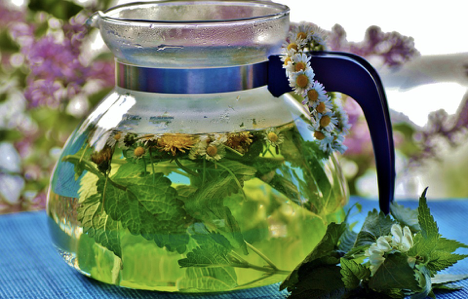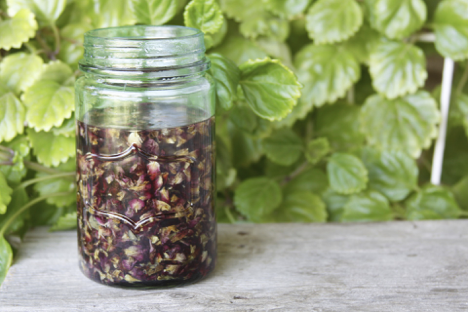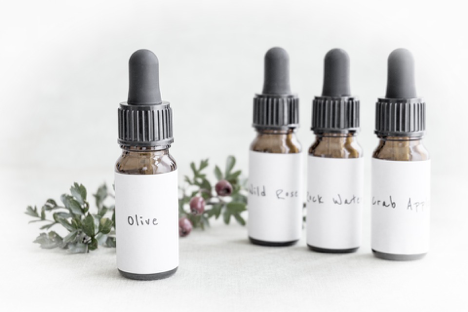Infusing and tincturing are two methods of extracting the beneficial elements of an herb. Many people extract herbs in order to enjoy the pleasures of a fragrant or calming beverage or for a myriad of health support benefits.
Infusions involve steeping the herbs in very hot water for a period of time to make a “tea” which can be drunk immediately, steeped for a long time or refrigerated for an iced beverage. Most commercially available herbal teas are actually just herbal infusions called tisanes and not technically tea if they don’t contain the tea plant (camellia sinensis).
However, there are a number of reasons one might choose to make a tincture instead of an infusion. If you want to use your herbs for health or dietary supplementation reasons you may want to try tincturing. This is particularly preferable if the herb doesn’t have a pleasant taste or aroma. It’s also beneficial if you want to be able to use herbal supplementation quickly and efficiently without having to drink a whole cup of tea.
Making your own herbal infusions and tinctures is super simple and you may wonder why you’ve never tried it before.

Making An Herbal Infusion
To make a quick and simple infused herbal tea (or tisane), you will need 1 or 2 tablespoons of your choice of fresh herbs or a teaspoon of dried herbs for every 8 ounces of water you are using. Gently bruise or chop the fresh leaves and place the fresh or dried leaves into a heatproof cup or measuring cup. You can put them in a tea ball or strain them later. Pour very hot water, just off the boil, over the herbs. Allow the leaves to steep for at least five minutes or until you get the desired flavor. Strain the herbs or leave them in the bottom of the cup as you sip. If the brew is bitter, or just if you prefer, add raw local honey to taste.
Here are a few excellent herbs for tisanes that are easy to grow yourself. Each with beneficial effects, they are pleasantly flavored and enjoyable to drink.
Chamomile – For calming and relaxation. Makes an excellent before bed beverage.
Peppermint – Great for indigestion and calming upset tummies, or just for enjoyment.
Red Raspberry Leaf – Straight from your raspberry canes, these leaves are especially helpful for calming menstrual cramps. The mild flavor is quite delicate and can be combined with other herbs.
Long Infusion
For a more robust extraction, you can do a long infusion. In a quart mason jar, or other heatproof glass container, place your dried or fresh herbs. You’ll want to use about a cup of fresh herb leaves for each quart of water or about 1/3 cup of dried. Pour boiling water over the herbs to the top of the jar. Seal the jar and allow to steep for at least 4 hours and up to 10 hours. When you are done, strain the herbs and use immediately or place the infusion in the refrigerator.
Long infusion should be done sparingly because the resulting brew may be very bitter and undrinkable with some herbs. Herbs that grow bitter with long infusion may be better as a tincture, if you want the health benefits and aren’t trying to enjoy the flavors so much.
Some herbs that do well with a long infusion include:
Mullein – Easy to grow, the fuzzy mullein leaf makes a good cough and congestion relieving beverage.
Comfrey – Sometimes called knitbone, comfrey is beneficial to promote tissue and bone repair, as well as a digestive aid.

Making an Herbal Tincture
To tincture your preferred herb, you will need a quantity of drinkable alcohol. You can use either pure grain alcohol or plain vodka. Even though pure grain alcohol is more alcoholic per ounce, it is often still cheaper to buy cheap vodka. In my experience, there is no benefit to getting more expensive vodka so get the cheapest available.
You don’t have to get too fussy about the amounts here, but generally you should use one cup of fresh herbs to 3 cups of alcohol, but you can use up to 3 cups of fresh herbs to 3 cups of alcohol.
Place the herbs into a sealable glass jar and cover with the alcohol. It’s that simple. Now put the sealed jar away in a cool, dark place for 2 to 6 weeks. Gently shake the jar every other day or so. You can leave the herbs in there for up to 6 months, but the you really don’t need to, because not much more extraction will happen after about 6 weeks.
After you are done extracting, you can strain the tincture and transfer it to dark-colored bottles, preferably brown, to protect your tincture from sunlight. I save and carefully clean glass bottles with glass droppers from tinctures I have purchased.

If you do not wish to use alcohol to tincture, you can extract your herbs using a good organic apple cider vinegar or food grade vegetable glycerin. Because these mediums will not protect your tincture from spoilage, you will need to refrigerate your tincture and use it within 4 to 6 months.
While some herbs are best tinctured, really any herb can be tinctured for preservation and concentration.
Author Bio: Willow, an avid organic gardener, and TJ, a Certified Permaculture Designer, when not gardening or working their acreage, are busy helping you make the most of your outdoor corner of the world at LawnLifestyles.com.
